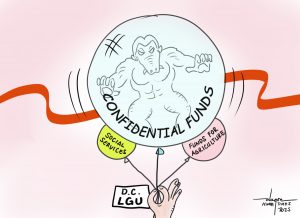 THIS afternoon starting at 1 o’clock, a joint hearing will be conducted by three committees of the Davao City Council on the much anticipated Samal Island-Davao City (SIDC) connector bridge project, the implementation of which is now slowly evolving.
THIS afternoon starting at 1 o’clock, a joint hearing will be conducted by three committees of the Davao City Council on the much anticipated Samal Island-Davao City (SIDC) connector bridge project, the implementation of which is now slowly evolving.
The committees initiating the public hearing are the Environment and Natural Resources, Public Works and Highways, and Tourism. But of course, these are the components of government bureaucracy that are the drivers of the uproar on the project, not necessarily against it but on its possible impact once construction goes full-blast.
We appreciate the move of the Council Committees on convening people and entities who are considered leading or major stakeholders in the bridge project. But is this hearing rather too late in the day?
We are raising this question because somehow, the Department of Public Works and Highways (DPWH), the lead agency in the project realization, is seemingly all set to start the work, a move that we can understand considering the length of time from the approval of the project until now that its starting activities should have been fully done minus every possible hindrance.
Will the outcome of the joint hearing today, say resolutions, recommendations, etc., etc. matter now? Well, as to forcing a change in the alignment of the bridge that necessarily triggers a revision in its design and cost, it is our take that it will not.
Possibly the most that the joint hearing can come up if only to assuage the serious hurt the project can do to the adversely affected stakeholders, is to craft a resolution recommending strict implementation of the various mitigating measures that are intended to cushion the impact of the project on businesses, livelihood, and the environment on the long term.
In fact, we believe that the joint hearing will be more fruitful if the committees concerned can present to the attendees the mitigating measures earlier assured to be had by the DPWH and the DENR. Maybe the hearing can be a venue for refining the measures and crafting parameters with which all these can be successfully undertaken.
It is also our take that it would be wise for the committees to give importance to the inputs that may come out from the various resource persons as these are reflective not only of their personal interest but also their perception of the public’s views on the conflicting issues.
But again, this joint hearing would have served its purpose best had this been done at the height of the deliberation of the project by the planning bodies of the different local governments in the Davao Region.
For now, the hearing is synonymous with a kitchen staff debating how the meals should have been prepared when everything is already cooked.
But let’s give the hearing’s outcome the benefit of the doubt as to whether or not it will still matter.
*************************
Talking of big-ticket projects in Mindanao, specifically in the Davao Region and Davao City itself, it is slowly dawning on us that the much talked about Mindanao Railway that will supposedly connect the southern and northern regions of the island, is already on the edge to oblivion.
Yes, what with the inclusion by China of the project as one of those that it has withdrawn its commitment to finance. The Railway project for Mindanao is, without a doubt, the biggest and most expensive project proposed by the national government.
In fact, the people of Davao del Norte, Davao City, and Davao del Sur were already at the peak of their excitement when it was reported that the first Phase covering the route from Tagum City via Davao City to Digos in Davao del Sur was to have started shortly before the term of Davaoeno President Rodrigo Duterte ended.
But somehow, the expectation became frustration instead as so many “buts” and “becauses” came along the way with the lamest of excuses, the failure to acquire road-right-of-way for the rail.
Now, the Mindanaoans’ best hope for the realization of the project is already a private citizen. With China withdrawing its commitment to provide loans for funding the project, the hope now shifts to the new administration’s inclusion of the Mindanao Railway Project in its renegotiation for funding support from China.


